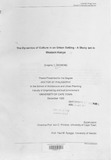| dc.description.abstract | Research was undertaken in the region that the research refers to as Western Kenya. This region brings together three cultural groups. In spite of the diversity of the community groups, past research identified development within the region that brought about the culture being shred between the communities.
The research undertaken set out to deal with two sets of issues. Firstly, the traditions that were manifest in the rural settlements in terms of kinship relations and patterns of behavior relating to important activities and rituals. There were also the cultural requirements that were jointly performed by kinsmen in the setting of the homestead and the related open outside areas. The second issue is the matter of the continuance of these traditions in the urban settlements
One of the basic assumptions underlying this research is the idea that any urban element of a regional town should be based on and influenced by the requirements of the surrounding culture. There are many reasons to support this idea. In most cases the majority of the residents of the regional town would be from the surrounding rural districts. In order that these people have a feeling of belonging in the urban setting, the respective urban elements should be responsive to their social and cultural needs.
Further, as an urban area grows and spreads, so it wraps round it and incorporates the surrounding rural areas. It is often the case that the urban elements that are on the edge or periphery of the expanding area are mostly those that are not formally planned. Often the building and planning regulations have not been enforced. Thus there is uncontrolled growth.
Past research in some towns has shown that the occupiers of the urban edge and other areas of uncontrolled growth still structure their life according to their cultural beliefs and also their individual and community obligations. The community would continue to hold on to those issues of culture that have been judged as necessary for identity and / or would provide security.
The research was structured to collect data from selected rural settlements as well as corresponding urban ones. The urban settlements selected were in the towns of Kisumu and Kisii. These two towns could be easily identified with a particular cultural group.
In Kisumu two neighborhoods were selected within the inner sector. In Kisii town, a settlement within the urban periphery, where urban and rural conditions met, was selected. All selected neighborhoods had been part of the urban landscape for over three decades. It was therefore assumed that the pattern of behaviors as well as adaptations made to the respective settings would have stabilized and it would be possible to evaluate the influence of traditional culture.
Research was also undertaken in the hinterland of these towns. Case studies were taken of a number of rural settlements. It was assumed that in the rural settlements the integrity of cultural behavior and the corresponding fit between community activities and their respective settings would provide a point of departure for comparison with the urban settlements
This research has found that in both the urban and rural settings, the appropriate use of space is critical to certain important issues, to which far greater meaning is attached than normal daily exchanges. An example is the spatial relationship between the different levels of kinship, the context in which some of the themes for certain rites of passage should be held, and the general setting available for community activities.
The research has found that in the region of study particular meaning was attached to the spatial context where some of the cultural activities were enacted. Some celebrations for the rites of passage, forms of kinship relationships and events that involved the community required a specific setting.
The research found that some of the cultural events judged as being of social significance were scheduled to take place within the outside open setting. Spatial requirements and the required behaviour between some of the kinship members should be one of the primary reasons influencing the selection of an activity venue.
In the town, three forms of development were noticed. The first one is that within any of these towns, the expansion of the edge is an ongoing process. Those people residing in the traditional homesteads are absorbed in the urban territory with a consequent change of context. The second development is that with all the towns, the large size of unplanned neighbourhoods makes them important urban areas having a great social impact. The third is that with the increase of rental dwellers, there is a change from a simple traditional type of settlement to a more complex one, with a related impact on the enactment of traditional rituals and the corresponding usage of the related settings.
From the analysis of the data that was collected, this research has developed a recommendation in the form of policy guidelines. This should form part of the policy guidelines that may influence the structuring of some of the elements of a regional town. The types of urban elements provided should attempt to meet local cultural and social needs, and should be capable of providing settings that are congruent with those needs, and should be responsive to the customary usage of the open outside areas where some of the important regional cultures are performed. In this way the neighbourhoods would provide the preconditions for individual and group identity and social security for its dwellers by supporting them in their social and cultural activities and in the continuity of their traditional culture. | en |

